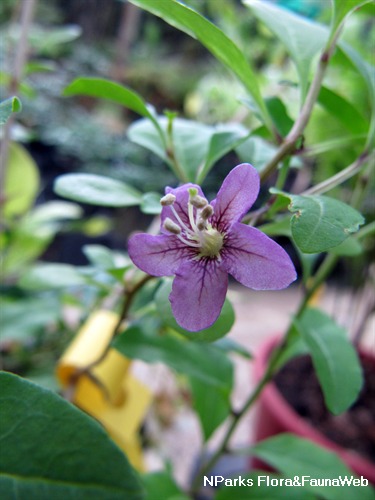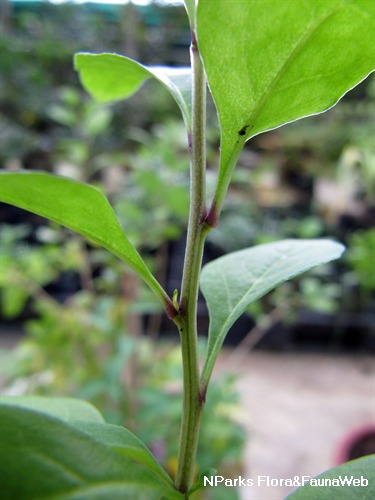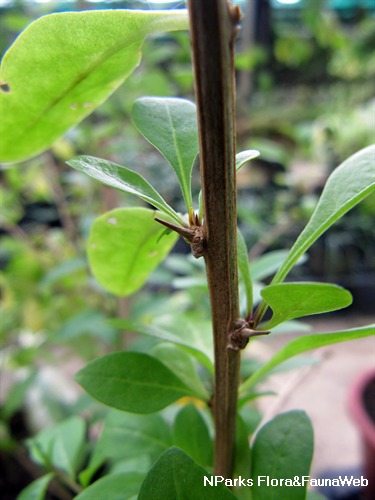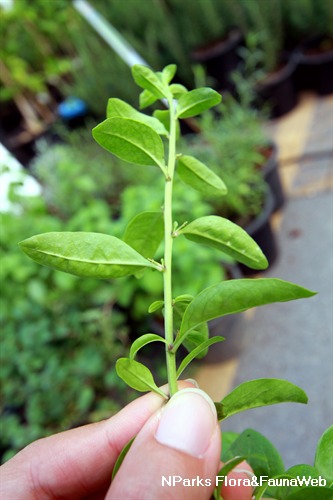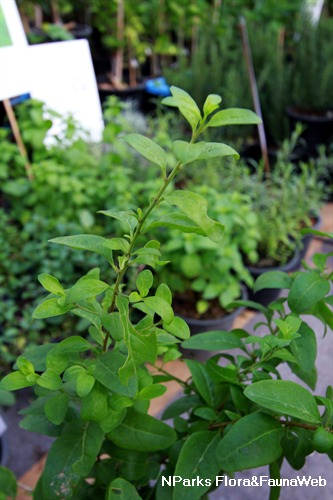
Back
Lycium chinense Mill.
| Family Name: | Solanaceae |
| Common Name: | Chinese Boxthorn, Chinese Desert-thorn, Chinese Matrimony Vine, Goji Berry, Chinese Wolfberry, 枸杞 |
Name
Classifications and Characteristics
| Plant Division | Angiosperms (Flowering Seed Plants) (Dicotyledon) |
|---|---|
| Plant Growth Form | Shrub |
| Lifespan (in Singapore) | Perennial |
| Mode of Nutrition | Autotrophic |
| Plant Shape | Irregular |
| Maximum Height | 0.5 m to 1 m |
| Maximum Plant Spread / Crown Width | 0.9 m to 3 m |
Biogeography
| Native Distribution | China, Japan |
|---|---|
| Native Habitat | Terrestrial (Temperate Forest) |
| Preferred Climate Zone | Temperate |
| Local Conservation Status | Non-native (Horticultural / Cultivated Only) |
Description and Ethnobotany
| Growth Form | Multi-stemmed shrub with erect or sprawling branches up to 1 m tall (rarely up to 2 m tall). |
|---|---|
| Foliage | Bright green leaves vary in size and may be elliptic, lanceolate, rhombic or ovate (2.5-7.6 cm long). |
| Flowers | Light purple to pale bluish purple, tubular flowers are typically solitary or paired. |
| Fruit | Bright red, egg-shaped to oblong berries taste somewhat like cherries or cranberries. Cultivars are 2.2 cm long and 1 cm wide, while wild fruits are 0.7-1.5 cm long and 5-8 mm wide. |
| Ethnobotanical Uses | Edible Plant Parts : Edible Fruits, Edible Seeds Food (Fruit or Vegetable): The berries are rich in Vitamins A and C, beta-carotene, iron and antioxidants. (Herb or Spice) Medicinal: The berries are used to make herbal tea. In China, Japan and Korea, the berries have been consumed for over 2,000 years, because they are thought to increase longevity and strengthen the immune system. |
Landscaping Features
| Desirable Plant Features | Ornamental Fruits |
|---|---|
| Landscape Uses | Parks & Gardens, Trellis / Arbour / Pergola, Hedge / Screening |
| Thematic Landscaping | Economic Garden |
| Usage Hazard - Cons | Spines/Thorns - Stem/Branch |
Fauna, Pollination and Dispersal
| Pollination Method(s) | Biotic (Fauna) (Insects (Bee)) |
|---|
Plant Care and Propagation
| Light Preference | Full Sun |
|---|---|
| Water Preference | Moderate Water |
| Rootzone Tolerance | Drought Tolerant, Well-Drained Soils |
| Propagation Method | Seed |
Foliar
| Foliage Retention | Deciduous |
|---|---|
| Mature Foliage Colour(s) | Green |
| Foliar Type | Simple / Unifoliate |
| Foliar Arrangement Along Stem | Alternate |
| Foliar Attachment to Stem | Petiolate |
| Foliar Shape(s) | Non-Palm Foliage (Ovate, Lanceolate, Elliptical) |
| Foliar Venation | Pinnate / Net |
| Foliar Margin | Entire - Wavy / Undulate |
| Foliar Apex - Tip | Acute |
| Foliar Base | Attenuate |
Floral (Angiosperm)
| Flower Colour(s) | Purple |
|---|---|
| Flower Grouping | Solitary, Cluster / Inflorescence |
| Flower Location | Axillary |
| Flower Symmetry | Radial |
| Individual Flower Shape | Funnelform / Funnel-shaped |
| Flower Colour(s) Remarks | Bluish Purple |
Fruit, Seed and Spore
| Mature Fruit Colour(s) | Red |
|---|---|
| Fruit Classification | Simple Fruit |
| Fruit Type | Fleshy Fruit , Non-Accessory Fruit |
| Mature Seed Colour(s) | Yellow / Golden |
| Seed Quantity Per Fruit | Numerous (>20) |
Image Repository
Others
| Master ID | 31794 |
|---|---|
| Species ID | 6194 |
| Flora Disclaimer | The information in this website has been compiled from reliable sources, such as reference works on medicinal plants. It is not a substitute for medical advice or treatment and NParks does not purport to provide any medical advice. Readers should always consult his/her physician before using or consuming a plant for medicinal purposes. |

